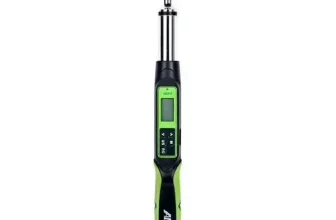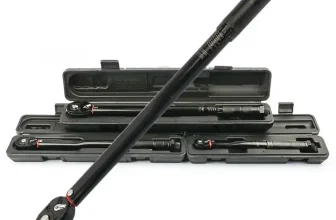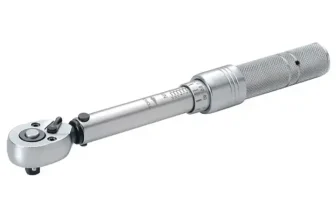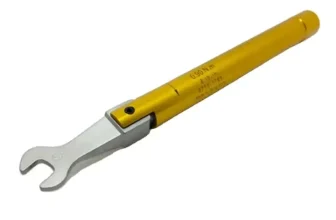A torque wrench is a specialized tool used to apply a specific, pre-set amount of force to a fastener, such as a nut or bolt. This purpose-built tool is designed to prevent over-tightening, which can lead to the damage of parts or the stripping of screw threads. Torque wrenches are vitally important in some fields, particularly in automotive repair, aeronautics, and industrial assembly, where the precise tension of screws and bolts can be critical. They come in a variety of types – click, electronic, beam, and the dial type – and sizes, based on the measurement of torque they deliver, and the kind of task they’re designed to handle. The precise and controlled application of torque is the primary reason these wrenches are a favorite among professionals in many industries.
Importance of calibration for accuracy
Calibration plays an integral role in maintaining the accuracy of a torque wrench. Without the right calibration, the wrench might over-torque or under-torque, compromising the integrity of the fastener’s connection. It’s worth noting that a few pounds of inaccuracy can significantly impact the functionality of the equipment. Too much torque can lead to damaged components, while insufficient torque can result in loose connections. Therefore, regular calibration of your torque wrench is a non-negotiable requisite, safeguarding the accuracy of torque measurement, promoting operational efficiency, and ultimately fostering safety at the workplace.
Understanding Calibration
Definition and explanation of calibration
Calibration is a vital process that ensures the accuracy and reliability of any tool or instrument, including a torque wrench. The term “calibration” refers to the comparison of the tool’s measurements to a known standard or set of standards. In this case, it involves verifying and adjusting the output of your torque wrench to correspond accurately with specific torque values.
Calibration can be viewed as a synchronization process where the settings of a device are fine-tuned to coincide with a known magnitude. The objective is to minimize any measurement uncertainty by ensuring the precision of the tool’s output.
In the realm of torque wrenches, calibration ascertains that the tool’s indicated torque matches the actual torque it is applying. This is critical to prevent any inconsistencies or inaccuracies in tightening that can occur due to a tool being over or under its specifications.
In summary, calibration keeps your torque wrench operating objectively, eliminating guesswork while ensuring your device’s output is within the accepted variance determined by the industry you are working in.
Next up, we’ll dive into why calibration is so important for torque wrenches.
Reasons why calibration is important for torque wrenches
Calibration of torque wrenches is vital for a number of reasons. The most salient among them is to ensure the accuracy of the tool. Torque wrenches are precision instruments designed to provide specific amounts of torque to a fastener (like bolts and nuts). Any discrepancy in the torque output could result in either over-tightening or under-tightening, which can compromise the integrity of the fastener.
Over-tightening risks damaging the threads of the fastener, and could potentially lead to the fastener breaking or being extremely difficult to remove. On the other hand, under-tightening can lead to loose bolts that can affect the stability of the assembly, resulting in safety concerns.
Additionally, routine calibration maintains the longevity and reliability of the torque wrench. Without proper calibration, the tool’s internal mechanisms can wear unevenly, leading to malfunction or failure over time. This could lead to unforeseen expenses related to repair or replacement.
Moreover, in professional environments, having a calibrated torque wrench is often a requirement to meet safety standards and regulations. Inaccuracy in torque could lead to catastrophic failures, particularly in industries like automotive, aerospace, construction, and manufacturing, where torque specifications are crucial. Therefore, ensuring that a torque wrench is calibrated and therefore reliable, is indispensable for both the safety and success of operations.
When to Calibrate a Torque Wrench
Regular intervals for calibration
Establishing regular calibration intervals for your torque wrench is important for maintaining its accuracy and increasing its lifespan. The frequency of calibration largely depends on how often the torque wrench is used and the degree of accuracy required in your applications.
Manufacturers often recommend calibrating a torque wrench every 5,000 to 7,000 uses, or every 12 months, whichever comes first. However, if the wrench is used daily in professional settings, calibration should ideally be done every three to six months.
It’s important to note that this is only a general guideline. For critical applications where precision is of utmost importance, more frequent calibration may be necessary. The environment in which the tool is used can also affect calibration intervals. For example, if the wrench is used in highly corrosive environments or exposed to extreme temperatures, calibration might need to be more frequent.
Maintaining a record of each calibration, including the date and any adjustments made, can be useful in determining an appropriate recalibration schedule for your particular tool. With time, you’d be able to identify a pattern that can help predict when your torque wrench is likely to go out of calibration. Thus, regular calibration intervals, tailored to individual usage and conditions, allow for the reliable and accurate functioning of your torque wrench.
Situations that necessitate immediate calibration of a torque wrench
In addition to regular intervals, certain situations call for immediate calibration of a torque wrench. This ensures tool accuracy and prevents potential issues that may arise from improper torque application. One such instance is when the torque wrench has been dropped or hit with force. The impact can significantly alter its calibration, leading to inaccurate readings and application.
Another scenario requiring immediate calibration is when the torque wrench has been used beyond its capacity. Over-torque can skew the calibration of the tool, rendering it unreliable for future use.
If you are continuously using the same torque setting for a long time, it is advisable to get your tool calibrated. Excessive use at one setting may cause the wrench to lose its precision over that particular range.
Finally, if the wrench produces inconsistent readings or shows clear signs of malfunction, it should be calibrated at once. Using a malfunctioning torque wrench can lead to disastrous consequences, including over-tightening, tool breakage, or application failure. Always pay attention to tool performance and recalibrate as necessary to ensure accurate torque application.
Industry Standards for Torque Wrench Calibration
Standard requirements from ISO and other industry bodies
The International Organization for Standardization (ISO) is a globally accepted authority that has set specific standards for calibrating torque wrenches, among other types of hardware. According to ISO 6789 standards, torque tools must be calibrated to achieve accurate and consistent results.
This standard states that a newly manufactured torque wrench should maintain its calibration level up to 5000 cycles or one year, whichever comes first. However, once the tool is in use, calibration intervals can get shorter, depending on how frequently and intensely the wrench is used.
The ISO 6789-2:2017 standard provides guidelines on how to implement control processes for ensuring that the calibration is maintained. It recommends procedures for testing and resetting the torque wrench to its original ISO calibration settings.
On the other hand, the American Society for Testing and Materials (ASTM) has also proposed a set of standards for torque wrench calibration. The ASTM Standard F2831-16 prescribes the calibration method for electronic or mechanical torque wrenches using a joint simulator with a single measurement range.
It’s worth noting that different industry bodies might slightly differ in their recommended standards, like the Aerospace Industries Association (AIA) which has its norms for aircraft production. SAE International also provides standards tailored specifically to automotive industries.
By adhering to these industry standards, you can ensure that your torque wrench delivers the right amount of force every time it’s used, maintaining the lifespan of the parts and the safety of the operations.
Comparisons between different industry standards
Across different industries, there’s noticeable uniformity in standards regarding torque wrench calibration, and most organizations adopt recommendations from international standard bodies such as ISO. However, nuances exist depending on the specificity and sensitivity of work performed in different sectors.
ISO 6789:2003 is the international standard that most industries abide by due to its comprehensive guidelines. This standard mandates that torque tools must be calibrated at least once every twelve months. However, for industries such as aerospace, automotive and medical, where precision is of utmost importance, companies often choose more frequent calibrations to ensure absolute accuracy.
ASTM International, a globally recognized leader in the development of standards, suggests different calibration cycles depending on usage. ASTM F2833-11, their relevant standard, recommends calibration every 2,500 cycles or every 12 months, whichever comes faster.
In the nuclear industry, they observe the ANSI/ASME NQA-1, which requires rigorous quality assurance processes that often necessitate more frequent calibration, sometimes as often as somewhat every 3 months.
In the UK, the British Standards Institute (BSI) generally recommends adherence to ISO 6789 but also suggests more frequent calibration for high workload tools.
In summary, while ISO 6789:2003 provides a good baseline for calibration cycles, specific industry requirements and the frequency of use may necessitate more regular calibrations. It’s crucial to understand not just the international standards but also the specific demands of your industry to ensure accuracy and safety at all times.
Choosing a Calibration Service
Factors to consider when choosing a calibration service
When selecting a calibration service for your torque wrench, there are several factors that one should consider.
Firstly, expertise and experience are paramount. The chosen provider should have a proven track record in calibrating torque wrenches. They should also have a professionally trained staff equipped with the necessary skills to accurately calibrate torque tools to the required standards.
Secondly, accreditation is vital. The service provider should have the necessary certifications to show they meet all regulatory standards. For example, a lab accredited to ISO 17025 means they have demonstrated technical competence and are maintaining their standard of calibration.
Thirdly, turnaround time is a crucial factor. Depending on the usage of your torque wrench, prolonged downtime may not be feasible. The faster the calibration service can calibrate your tool and get it back to you, the better.
Fourthly, communication is key. A good calibration service will provide you with a detailed calibration report, outlining the tool’s performance and notifying you of any potential issues.
Lastly, but importantly, the cost of service is a concern. However, it is prudent not to compromise other factors for cost, as the potential repercussions of an improperly calibrated torque wrench could be substantially more expensive.
Thus, it is best to do extensive research, check reviews and ratings of potential providers, ask relevant questions, and make an informed decision when choosing a calibration service.
The benefits of professional calibration
Professional calibration services offer numerous benefits that can enhance the longevity and efficiency of your torque wrench.
Firstly, precision is key. With professional torque wrench calibration services, you’re assured a high level of accuracy, as these experts have the knowledge and skills required to calibrate the tool to exact specifications. This results in an optimally functioning torque wrench that delivers accurate, reliable results.
Secondly, professional service providers often use sophisticated equipment and adheres to strict industry standards. This means that the calibration process is more detailed and comprehensive compared to doing it yourself. They ensure your tool is calibrated properly and is in compliance with any relevant standards like ISO 6789.
Additionally, professional calibration services often provide documented proof of the procedure. This traceable documentation is crucial, especially for businesses operating in highly regulated industries where it’s necessary to provide proof of adherence to set guidelines and standards.
Another notable advantage is the potential for increased longevity of the tool. Regular calibration by professional services helps in early detection of any issues that may otherwise go unnoticed, minimizing the risk of damage or premature wear and tear of the torque wrench.
Lastly, engaging professional calibration service saves you time and effort. Instead of you having to figure out how to calibrate your torque wrench correctly, the professionals handle the task, allowing you to focus on what you do best. This convenience is extremely beneficial, especially for businesses where time is of the essence.
Hence, while getting your torque wrench calibrated by a professional incurs a cost, it is a worthwhile investment given the enhanced accuracy, compliance with industry standards, proof of calibration, tool longevity, and the time saved.
Potential Consequences of Neglecting Calibration
Risks associated with over-torque
Over-torque is one of the major potential risks associated with neglecting the calibration of a torque wrench. When more torque is applied to a fastener than necessary, there can be several detrimental repercussions.
The most immediate risk of over-torque is damage to the fastener itself. A nut, bolt, or screw that is tightened too much could be stripped or even broken, rendering it useless. This could also potentially damage the item being fastened, leading to even more cost and time spent on repairs.
There’s also a real risk to the integrity of the structure being assembled. Parts that are bolted together with excessive force can deform or misalign, leading to structural weakness. This could potentially cause failure, especially if the fasteners are a critical part of the load-bearing structure.
Over-torque can lead to greater wear and tear on your torque wrench as well. The excessive force exerted by the wrench can strain its internal components, leading to inaccuracies and shortening the life of the tool.
Finally, problems due to over-torque may not be immediately apparent. Excessive stress on a fastener can lead to premature failure over time, with possibly catastrophic results if the fastener was securing a critical component. Therefore, maintaining the proper calibration on your torque wrench is crucial to avoid the risky and potentially expensive issue of over-torque.
Risks associated with under-torque
Under-torquing is a common issue that stems from the neglect of regular torque wrench calibration. It refers to the scenario where a less-than-specified amount of torque is applied to a fastener. The primary concern with under-torquing is that it fails to secure the fastener properly, leading to an array of potential complications that can have a significant impact on your work, safety, and equipment life.
One inevitable instance that can ensue from under-torque is the loosening of nuts and bolts. When fasteners are not tightened to their recommended specifications, they tend to unwind, particularly under conditions of vibration or regular physical stress. This can lead to system instability and, in extreme cases, can cause components or entire machinery to dismantle, resulting in hazardous working environments and equipment failures.
Furthermore, the disparity between parts that results from loosened joints forms an avenue for excessive wear and tear. The undue friction between these components may cause premature failures and significantly cut down the lifespan of your equipment.
Another risk associated with under-torque is the uneven distribution of stress. Proper torque supplies an even clamping force that distributes load evenly across the joint, maintaining the integrity of the assembly. When insufficient torque is applied, this balance is disrupted. This can result in distortions, misalignment, and increased risk of material fatigue, culminating in reduced efficiency, compromised safety, and ultimately, system failure.
Under-torque can also lead to leakage in applications where a secure seal is paramount. This is especially critical in hydraulic systems, gas conduits, and various other systems, where even the slightest seepage can lead to inefficiencies, safety issues, or total system breakdown.
In light of all these potential complications, it’s clear that regular calibration of torque wrenches plays a pivotal role in ensuring the application of precise torque, thereby safeguarding the integrity and longevity of your assemblies and machinery.
Long-term effects on the wrench and your work
Neglecting the calibration of a torque wrench can have long-term effects on both the wrench itself and the quality of your work.
As the accuracy of a torque wrench diminishes over time due to normal wear and tear or accidental falls, it can lead to misalignment or premature wear of components. In extreme cases, it can even render a torque wrench unusable. Additionally, a less obvious consequence of neglecting calibration is that a poorly maintained wrench may become less efficient over time and more physically challenging to operate, which can potentially lead to user fatigue and reduce productivity.
Furthermore, when it comes to the impact on your work, a wrench that hasn’t been calibrated appropriately may result in the over-torquing or under-torquing of bolts. This can compromise your work’s quality and, on a larger scale, may even lead to the failure of the entire system you’re working on. For instance, in an automotive setting, an improperly torqued bolt can lead to unnecessary vibration, wear, and even safety issues such as the failure of important parts.
In industries where precision is key, such as aerospace, manufacturing, and engineering, failing to meet the precise torque specifications can bring about catastrophic results. For this reason, numerous industry standards require regular calibration of torque wrenches to ensure the accuracy of torque applications.
In conclusion, although it might seem like an extra step or an unnecessary expense, regular calibration of a torque wrench is fundamental to its longevity, the quality of your work, and the prevention of potentially significant challenges down the line. Regular calibration is not only good practice but also a prudent preventive measure that mitigates risks and costs related to damage and malfunction.
How to Check the Calibration of a Torque Wrench
Step-by-step guide on how to check calibration
Checking the calibration of your torque wrench is a process that you can conduct on your own to ensure the accuracy of your tool. Here is a step-by-step guide:
-
Gather Required Materials: First, you will need a vice, a measuring tape or ruler, and a known weight that can hang from the wrench, such as a weight with an included handle.
-
Secure the Torque Wrench: Place the square drive of your torque wrench into the vice, making sure it’s locked securely in place. The handle should be able to move freely.
-
Measure the Wrench: Using your measuring tape or ruler, measure exactly one foot from the square drive along the length of the wrench and make a small mark. This is where you will hang your weight.
-
Hang the Weight: Hang your known weight on the mark you made. Be sure to allow it to hang freely and not touch any part of the vice or bench.
-
Check the Reading: With the weight hanging freely, look at the setting window on the handle of the torque wrench. It should read the equivalent of the force applied which is calculated by the weight you hang multiplied by the distance it’s hung from (in foot).
For example, if you hang a 10-pound weight one foot from the square drive, the torque wrench should read 10 foot-pounds. If your torque wrench doesn’t provide this reading, it may require recalibration.
Remember to always follow safety precautions while performing this test. Wear protective gear, including safety glasses, and handle weights carefully to prevent injury.
Please note that this test is rudimentary and is not meant to replace professional calibration services – it should merely function as a quick-check method. For precision tasks, always rely on professional services for your calibration needs.
Signs that your torque wrench needs calibration
Determining whether your torque wrench needs calibration isn’t always straightforward. Below, you’ll find several signs that could indicate it is time to service your tool.
-
Inconsistent Readings: If you’re getting wildly differing torque readings on the same bolt, it may be a signal that your torque wrench isn’t properly calibrated. Consistency is a key attribute of a well-calibrated torque wrench.
-
Unexpected Looseness or Tightness: If the bolts you’re tightening with your torque wrench consistently end up either too tight or too loose, the wrench may need calibration. A properly calibrated wrench should enable you to secure bolts with just the right level of tightness.
-
Excessive Wear or Damage: Look for visible signs of wear or damage on your wrench. If your torque wrench is damaged or excessively worn, it may not be able to hold its calibration effectively. Any such physical deterioration calls for immediate calibration.
-
It’s been dropped: A dropped wrench can easily get out of calibration. If you’ve recently dropped your torque wrench, especially from a significant height, you’ll likely need to recalibrate it.
-
It Hasn’t Been Calibrated Recently: Regular preventive calibration is always a good idea, regardless of how the tool seems to be performing. If it’s been a year since your torque wrench’s last calibration, or it has been used heavily since the last check, this in itself is a red flag.
Remember not to ignore these signs if you want your tool to deliver optimal results and prolonged service life. Regular checks and calibration can save you from costly reworks and ensure the longevity of your torque wrench.
Conclusion
Regular calibration of torque wrenches is crucial in preserving the accuracy, efficiency and longevity of your tool. A properly calibrated torque wrench ensures you apply the correct amount of force in your work and helps you to avoid over-torquing or under-torquing. These are not just beneficial to the torque wrench itself but to the entire project’s quality and safety. Remember that apart from following a regular calibration schedule, the necessity for calibration could also be influenced by the tool’s frequency of use, maintenance practices, and working conditions.
Neglecting regular calibration can lead to problematic consequences. On one hand, over-torquing can overstretch or break parts, while on the other hand, under-torquing can cause parts to be loose and not function properly. In both scenarios, the results are potential disasters that could mean damaged equipment, wasted resources, and even compromise safety.
Beginning to view calibration as an essential part of your tool maintenance routine can significantly improve the longevity of your torque wrench and the quality of your projects. Consider availing the services of a professional calibration company, which will provide not just accuracy but also detailed documentation, ensuring that you are meeting industry standards.
Investing in calibration on a regular basis is a small price to pay to ensure safety, avoid unnecessary costs, and deliver the best output in your work. Owning a torque wrench means a commitment to regular calibration – never underestimate its importance.







